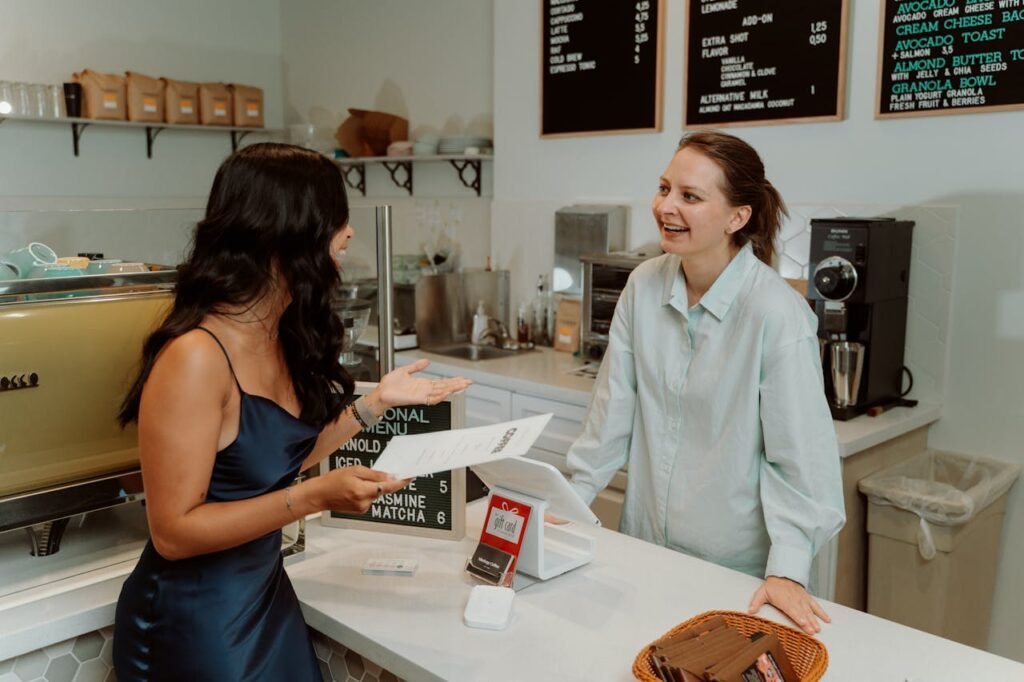Running a restaurant is not just about serving great food; it’s about getting customers through the door. Local marketing strategies are essential for boosting your restaurant’s visibility and attracting new patrons. By focusing on your local community and understanding their needs, you can create tailored marketing campaigns that drive traffic and build loyalty.
Understanding Your Local Market
Analyzing Local Demographics
To effectively market your restaurant, you need to understand the local demographics. Who are the people in your community? What are their preferences, habits, and lifestyles?
Gather data on age groups, income levels, family sizes, and dining preferences. This information will help you tailor your marketing efforts to meet their specific needs.
Conduct surveys, engage with customers, and analyze existing data to get a clear picture of your target audience. Understanding these details allows you to create menus, promotions, and events that resonate with your local market.
Identifying Local Trends
Stay updated with the latest trends in your local area. Are there specific cuisines gaining popularity? Is there a growing interest in healthy eating, vegan options, or farm-to-table dining?
Identifying these trends can help you adjust your menu and marketing strategies accordingly.
Attend local events, join community groups, and keep an eye on social media to stay informed about what’s trending. By aligning your offerings with local preferences, you can attract more customers who are interested in trying something new and trendy.
Enhancing Your Online Presence
Optimizing Your Website
Your website is often the first point of contact for potential customers. Ensure it is user-friendly, mobile-responsive, and contains all necessary information. Include your menu, location, hours of operation, and contact details. High-quality photos of your dishes can entice visitors and give them a glimpse of what to expect.
Implement local SEO strategies to make your website more discoverable in local searches. Use relevant keywords, such as “best restaurant in [Your City],” in your content.
Create a blog that covers topics related to your restaurant and the local food scene to attract more organic traffic.
Leveraging Google My Business
Google My Business (GMB) is a powerful tool for local marketing. Claim and optimize your GMB listing to enhance your restaurant’s visibility on Google Search and Maps. Ensure your listing is complete with accurate information, including address, phone number, website, and business hours.
Encourage satisfied customers to leave positive reviews on your GMB listing. Respond to reviews, both positive and negative, to show that you value customer feedback.
High ratings and active engagement can improve your search rankings and attract more customers.
Leveraging Social Media Platforms
Social media platforms are powerful tools for connecting with your local community and promoting your restaurant. Choose platforms that align with your target audience, such as Facebook, Instagram, and Twitter.
Develop a content calendar to plan and schedule your posts, ensuring a consistent presence.
Create a mix of content that showcases your restaurant’s personality and offerings. Share high-quality photos and videos of your dishes, behind-the-scenes glimpses, and customer testimonials.
Engage with your audience by responding to comments, asking questions, and encouraging user-generated content.
Social Media Marketing
Crafting a Strategic Social Media Plan
Developing a comprehensive social media strategy is essential for boosting your restaurant’s online presence and engaging with your local community. Start by defining your goals, whether it’s increasing brand awareness, driving foot traffic, or promoting specific menu items.
Align these goals with measurable objectives, such as gaining a certain number of followers or increasing engagement rates.
Creating Engaging Content
Social media is a vital platform for engaging with your local community. Create content that showcases your restaurant’s personality and offerings.
Share high-quality photos and videos of your dishes, behind-the-scenes glimpses, and stories about your staff and customers.
Engage with your audience by asking questions, responding to comments, and sharing user-generated content. Hosting social media contests and giveaways can boost engagement and attract new followers.
Use local hashtags to increase your visibility and reach a broader local audience.
Engaging with Local Influencers
Collaborating with local influencers can amplify your social media efforts and reach a broader audience. Identify influencers who align with your brand values and have a significant following in your target market.
Approach them with collaboration ideas that benefit both parties, such as sponsored posts, takeovers, or exclusive events.
Utilizing Facebook and Instagram Ads
Social media ads are effective for targeting specific demographics and interests. Use Facebook and Instagram ads to promote your restaurant to local users.
Create eye-catching ads that highlight your best dishes, special offers, and upcoming events.
Utilize the advanced targeting options to reach users based on their location, interests, and behaviors. Monitor the performance of your ads and adjust your strategy based on the results.
Social media ads can drive traffic to your website and increase foot traffic to your restaurant.
Showcasing Your Menu and Specials
Use social media to highlight your menu items and daily specials. Post high-quality photos and videos of your dishes, emphasizing their presentation and ingredients. Visual content is highly engaging and can entice potential customers to visit your restaurant.
Feature customer favorites and new additions to your menu. Use captions to tell the story behind each dish, whether it’s the inspiration, sourcing of ingredients, or preparation process.
This not only showcases your culinary expertise but also connects with your audience on a personal level.
Encourage customers to share their own photos of your dishes by creating a branded hashtag. This user-generated content can increase your reach and authenticity.
Hosting Local Events
Organizing Community Events
Hosting events can draw in crowds and create a buzz around your restaurant. Organize community events such as food tastings, cooking classes, or themed dinners. These events provide a unique experience and encourage customers to visit your restaurant.
Partner with local businesses, artists, or musicians to add value to your events and attract a wider audience. Promote your events through your website, social media, and local media outlets to ensure maximum attendance.
Successful events can generate word-of-mouth marketing and repeat visits.
Participating in Local Festivals
Local festivals and fairs are excellent opportunities to showcase your restaurant. Set up a booth or food truck at these events to reach new customers. Offer samples of your signature dishes and distribute promotional materials like flyers or coupons.
Engage with festival-goers and collect contact information for future marketing efforts.
Participation in local festivals can increase your restaurant’s visibility and attract customers who may not have otherwise discovered your establishment.
Building Relationships with the Community
Partnering with Local Businesses
Creating partnerships with other local businesses can enhance your visibility and attract more customers. Identify businesses that complement your restaurant, such as nearby shops, gyms, or entertainment venues.
Collaborate on joint promotions, events, or special offers that benefit both parties. For example, you could offer discounts to customers who show a receipt from a partner business or host a special event together.
These partnerships can help you tap into each other’s customer base and create a stronger community presence.
Supporting Local Charities and Causes
Supporting local charities and causes not only helps the community but also enhances your restaurant’s reputation. Host fundraisers, donate a portion of your sales, or provide meals for local events. Showing your commitment to the community can build goodwill and attract customers who value businesses that give back.
Promote your charitable activities on your website, social media, and in your restaurant. Highlight the impact of your contributions and encourage your customers to get involved.
Supporting local causes can strengthen your brand’s image and create loyal customers who appreciate your efforts.
Enhancing Customer Experience

Personalizing Customer Interactions
Personalized interactions can significantly enhance the customer experience and encourage repeat visits. Train your staff to recognize regular customers, remember their preferences, and offer personalized recommendations.
Simple gestures, like addressing customers by name or remembering their favorite dish, can make a big difference. Use customer data to send personalized emails or messages with special offers, birthday greetings, or updates about new menu items.
Personalization shows that you value your customers and are attentive to their needs, fostering a stronger connection with your brand.
Improving In-Restaurant Experience
The in-restaurant experience is crucial for customer satisfaction. Ensure that your restaurant offers a comfortable, welcoming environment. Pay attention to details such as cleanliness, ambiance, and customer service. Regularly gather feedback from customers to identify areas for improvement.
Consider offering complimentary items, such as appetizers or desserts, to enhance the dining experience.
Special touches like live music, themed nights, or interactive dining experiences can create memorable visits and encourage customers to return.
Utilizing Technology
Implementing Online Ordering and Delivery
Online ordering and delivery services have become essential for many restaurants. Partner with delivery platforms or create your own online ordering system to make it easy for customers to enjoy your food from home.
Ensure that your online menu is up-to-date, visually appealing, and easy to navigate. Promote your delivery services through your website, social media, and email marketing. Offer exclusive deals for online orders to encourage usage.
Efficient online ordering and delivery services can expand your customer base and increase sales.
Using Customer Relationship Management (CRM) Systems
A CRM system can help you manage customer data and improve your marketing efforts. Use a CRM to track customer preferences, purchase history, and feedback.
This information allows you to create targeted marketing campaigns and personalized offers. Analyze the data to identify trends and opportunities for improvement.
A CRM system can streamline your operations, enhance customer satisfaction, and drive repeat business.
Promoting Through Local Media
Engaging with Local Journalists and Bloggers
Local media coverage can significantly boost your restaurant’s visibility. Engage with local journalists and bloggers who cover the food and dining scene.
Invite them to your restaurant for a complimentary meal or a special event. Share your restaurant’s story, unique dishes, and any upcoming promotions.
Building relationships with local media can lead to positive reviews, feature articles, and social media mentions. This exposure can attract new customers and enhance your restaurant’s reputation in the community.
Advertising in Local Publications
Advertising in local newspapers, magazines, and online publications can effectively reach your target audience. Design eye-catching ads that highlight your best dishes, special offers, and unique selling points.
Include a clear call to action, such as visiting your website or making a reservation.
Track the performance of your ads to determine their effectiveness. Adjust your strategy based on the results to maximize your return on investment.
Local advertising can increase brand awareness and drive traffic to your restaurant.
Leveraging Online Reviews
Encouraging Positive Reviews
Positive online reviews can significantly impact your restaurant’s reputation and attract new customers.
Encourage satisfied customers to leave reviews on platforms like Google, Yelp, and TripAdvisor. Make it easy for them by providing direct links to your review profiles.
Respond to reviews promptly, thanking customers for their feedback and addressing any concerns. Positive interactions can enhance your online presence and show potential customers that you value their opinions.
Managing Negative Reviews
Negative reviews are inevitable, but how you handle them can make a big difference. Respond to negative reviews professionally and courteously. Acknowledge the customer’s concerns, apologize for any issues, and offer a solution or compensation.
Use negative feedback as an opportunity to improve your restaurant. Analyze recurring issues and take corrective actions.
Effective management of negative reviews can turn dissatisfied customers into loyal ones and demonstrate your commitment to quality and service.
Utilizing Email Marketing
Building an Email List
An email list allows you to communicate directly with your customers. Collect email addresses through your website, social media, and in-restaurant sign-ups.
Offer incentives, such as discounts or exclusive offers, to encourage sign-ups. Segment your email list based on customer preferences and behaviors to send targeted messages.
A well-maintained email list can enhance customer engagement and drive repeat business.
Creating Engaging Email Campaigns
Email marketing is a powerful tool for promoting your restaurant. Create engaging email campaigns that provide value to your subscribers.
Share updates about new menu items, special promotions, and upcoming events.
Use visually appealing designs and compelling content to capture your audience’s attention. Include clear calls to action, such as making a reservation or visiting your website.
Track the performance of your email campaigns and adjust your strategy based on the results.
Embracing Seasonal Marketing

Seasonal Menus and Promotions
Creating seasonal menus and promotions can attract customers who are looking for something new and exciting. Use seasonal ingredients to create special dishes that reflect the flavors of the season.
For example, offer fresh salads and light dishes in the spring, hearty soups and stews in the fall, and festive meals during the holiday season.
Promote these seasonal offerings through your website, social media, and email newsletters. Highlight the limited-time nature of these items to create a sense of urgency.
Seasonal menus and promotions can encourage repeat visits and give customers a reason to come back to try new items.
Hosting Seasonal Events
Seasonal events can draw in crowds and create a buzz around your restaurant. Host events that celebrate local holidays, cultural festivals, or seasonal changes.
For example, organize a summer barbecue, a fall harvest festival, or a winter holiday party. Promote these events through various channels to reach a broad audience. Offer special menus, live entertainment, and themed decorations to enhance the experience.
Seasonal events can generate excitement and attract new customers who are looking for unique dining experiences.
Implementing Loyalty Programs
Designing a Loyalty Program
A well-designed loyalty program can encourage repeat visits and build customer loyalty. Offer rewards such as discounts, free items, or exclusive access to events for customers who frequently dine at your restaurant.
Create a simple and user-friendly system for customers to earn and redeem rewards. Track their progress and send regular updates and personalized offers to keep them engaged.
A loyalty program can incentivize repeat business and foster long-term relationships with your customers.
Promoting Your Loyalty Program
Promote your loyalty program through your website, social media, and in-restaurant signage. Explain the benefits and how customers can sign up and start earning rewards.
Encourage your staff to mention the loyalty program to customers during their visit.
Highlight success stories and testimonials from satisfied members to build credibility and attract more participants.
A well-promoted loyalty program can drive customer engagement and increase your restaurant’s repeat traffic.
Utilizing Direct Mail Campaigns
Creating Effective Direct Mail Pieces
Direct mail campaigns can effectively reach local customers and promote your restaurant. Design visually appealing mail pieces that highlight your best dishes, special offers, and upcoming events.
Include clear calls to action, such as visiting your website, making a reservation, or bringing the mailer in for a discount.
Ensure your direct mail pieces stand out by using high-quality materials and eye-catching designs. Personalize the content to make it relevant to the recipients.
Effective direct mail campaigns can attract new customers and remind existing ones to visit again.
Targeting Your Direct Mail Campaigns
Target your direct mail campaigns to specific neighborhoods or demographics that are likely to visit your restaurant.
Use data and insights to identify areas with high concentrations of potential customers. Tailor your messaging to address their preferences and interests.
Track the response rates and ROI of your direct mail campaigns to measure their effectiveness.
Adjust your strategy based on the results to maximize the impact of your future campaigns. Targeted direct mail can drive local traffic and increase brand awareness.
Exploring Local Sponsorship Opportunities
Identifying Strategic Sponsorships
Finding the right sponsorship opportunities requires understanding your community and aligning with events that match your restaurant’s brand and values.
Start by identifying local events that attract your target audience. These could include sports events, cultural festivals, farmers’ markets, and community fairs.
Sponsoring Local Events
Sponsoring local events can enhance your restaurant’s visibility and build goodwill in the community. Look for opportunities to sponsor events such as sports tournaments, charity runs, or local festivals.
In exchange for your sponsorship, you can receive brand exposure through event signage, promotional materials, and mentions in event communications.
Engage with event attendees by setting up a booth, offering samples of your food, or providing exclusive event discounts.
Sponsoring local events can create positive associations with your brand and attract new customers.
Partnering with Local Schools and Organizations
Partnering with local schools and organizations can strengthen your community ties and attract family-oriented customers.
Offer fundraising opportunities where a percentage of sales on a specific night is donated to the school or organization.
Host special events or provide catering for their activities.
Promote these partnerships through your marketing channels and encourage your partners to do the same. Highlight the positive impact of these collaborations on your community.
Strong partnerships can increase your restaurant’s visibility and build a loyal customer base.
Creating Mutually Beneficial Partnerships
Sponsorship should be a two-way street. When approaching potential partners, highlight how your restaurant can add value to their event and how the partnership can benefit both parties. Offer to provide food and beverages, host event-related gatherings, or offer discounts to event attendees.
Develop sponsorship packages that outline different levels of involvement and benefits.
For instance, a basic package might include providing food samples at the event, while a premium package could involve a branded booth, co-branded marketing materials, and exclusive offers for event participants.
Maximizing Visibility at Sponsored Events
Once you’ve secured a sponsorship, focus on maximizing your restaurant’s visibility at the event. Set up an attractive booth or stall that reflects your brand’s personality. Use eye-catching banners, signage, and displays to draw attention.
Offer samples of your best dishes to entice attendees and give them a taste of what you offer.
Enhancing Visual Appeal

Improving Curb Appeal
Your restaurant’s exterior is the first impression potential customers will have. Ensure that it is inviting and reflects your brand’s identity. Invest in attractive signage, clean and well-maintained facades, and appealing outdoor seating areas if possible.
Seasonal decorations can add a festive touch and attract passersby. Consider using plants, lighting, and other decorative elements to enhance your curb appeal.
A visually appealing exterior can draw in more customers and create a positive first impression.
Creating Instagram-Worthy Spaces
In the age of social media, having Instagram-worthy spaces in your restaurant can attract customers who want to share their dining experience online. Design aesthetically pleasing interiors with unique decor, interesting lighting, and photogenic food presentations.
Encourage customers to share their photos by creating a branded hashtag and offering incentives, such as discounts for posting their visit on social media.
Feature the best photos on your restaurant’s social media profiles.
Instagram-worthy spaces can increase your online visibility and attract social media-savvy customers.
Wrapping it up
Boosting restaurant traffic through local marketing strategies involves a multifaceted approach that combines understanding your community, enhancing your online presence, engaging in social media marketing, exploring local sponsorship opportunities, and continuously improving customer experience.
By leveraging these strategies, your restaurant can build strong community ties, attract new customers, and foster loyalty among existing patrons.
For startup founders, the key to success lies in being strategic, adaptable, and customer-focused. Regularly analyze your marketing efforts, seek feedback from your customers, and stay updated with the latest trends and best practices.
By doing so, you can refine your approach and ensure your restaurant remains a beloved destination in your local area.
READ NEXT:
- Empowering Social Media Post Ideas for International Women’s Day
- Creative Social Media Post Ideas for Digital Marketing Agencies
- Tech-Savvy Social Media Content Ideas
- Spring into Action with Social Media Ideas for April
- Autumnal Social Media Ideas for October






















Comments are closed.